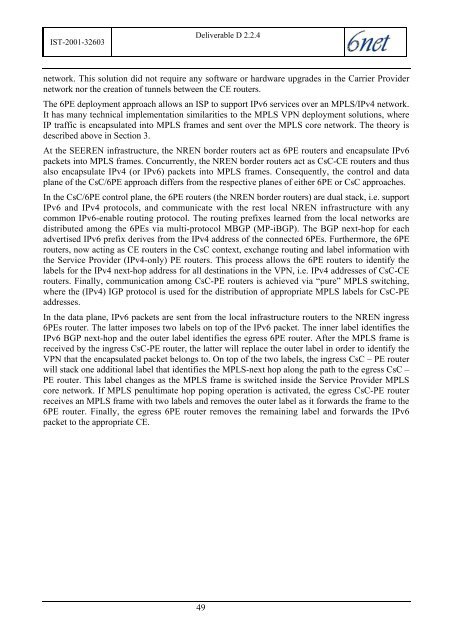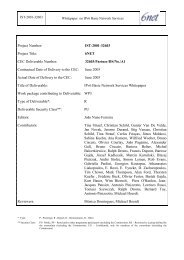D2.2.4: Final IPv4 to IPv6 Transition Cookbook for ... - 6NET
D2.2.4: Final IPv4 to IPv6 Transition Cookbook for ... - 6NET
D2.2.4: Final IPv4 to IPv6 Transition Cookbook for ... - 6NET
You also want an ePaper? Increase the reach of your titles
YUMPU automatically turns print PDFs into web optimized ePapers that Google loves.
IST-2001-32603Deliverable D 2.2.4network. This solution did not require any software or hardware upgrades in the Carrier Providernetwork nor the creation of tunnels between the CE routers.The 6PE deployment approach allows an ISP <strong>to</strong> support <strong>IPv6</strong> services over an MPLS/<strong>IPv4</strong> network.It has many technical implementation similarities <strong>to</strong> the MPLS VPN deployment solutions, whereIP traffic is encapsulated in<strong>to</strong> MPLS frames and sent over the MPLS core network. The theory isdescribed above in Section 3.At the SEEREN infrastructure, the NREN border routers act as 6PE routers and encapsulate <strong>IPv6</strong>packets in<strong>to</strong> MPLS frames. Concurrently, the NREN border routers act as CsC-CE routers and thusalso encapsulate <strong>IPv4</strong> (or <strong>IPv6</strong>) packets in<strong>to</strong> MPLS frames. Consequently, the control and dataplane of the CsC/6PE approach differs from the respective planes of either 6PE or CsC approaches.In the CsC/6PE control plane, the 6PE routers (the NREN border routers) are dual stack, i.e. support<strong>IPv6</strong> and <strong>IPv4</strong> pro<strong>to</strong>cols, and communicate with the rest local NREN infrastructure with anycommon <strong>IPv6</strong>-enable routing pro<strong>to</strong>col. The routing prefixes learned from the local networks aredistributed among the 6PEs via multi-pro<strong>to</strong>col MBGP (MP-iBGP). The BGP next-hop <strong>for</strong> eachadvertised <strong>IPv6</strong> prefix derives from the <strong>IPv4</strong> address of the connected 6PEs. Furthermore, the 6PErouters, now acting as CE routers in the CsC context, exchange routing and label in<strong>for</strong>mation withthe Service Provider (<strong>IPv4</strong>-only) PE routers. This process allows the 6PE routers <strong>to</strong> identify thelabels <strong>for</strong> the <strong>IPv4</strong> next-hop address <strong>for</strong> all destinations in the VPN, i.e. <strong>IPv4</strong> addresses of CsC-CErouters. <strong>Final</strong>ly, communication among CsC-PE routers is achieved via “pure” MPLS switching,where the (<strong>IPv4</strong>) IGP pro<strong>to</strong>col is used <strong>for</strong> the distribution of appropriate MPLS labels <strong>for</strong> CsC-PEaddresses.In the data plane, <strong>IPv6</strong> packets are sent from the local infrastructure routers <strong>to</strong> the NREN ingress6PEs router. The latter imposes two labels on <strong>to</strong>p of the <strong>IPv6</strong> packet. The inner label identifies the<strong>IPv6</strong> BGP next-hop and the outer label identifies the egress 6PE router. After the MPLS frame isreceived by the ingress CsC-PE router, the latter will replace the outer label in order <strong>to</strong> identify theVPN that the encapsulated packet belongs <strong>to</strong>. On <strong>to</strong>p of the two labels, the ingress CsC – PE routerwill stack one additional label that identifies the MPLS-next hop along the path <strong>to</strong> the egress CsC –PE router. This label changes as the MPLS frame is switched inside the Service Provider MPLScore network. If MPLS penultimate hop poping operation is activated, the egress CsC-PE routerreceives an MPLS frame with two labels and removes the outer label as it <strong>for</strong>wards the frame <strong>to</strong> the6PE router. <strong>Final</strong>ly, the egress 6PE router removes the remaining label and <strong>for</strong>wards the <strong>IPv6</strong>packet <strong>to</strong> the appropriate CE.49






